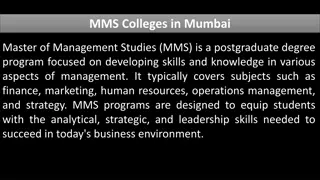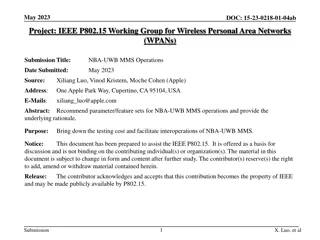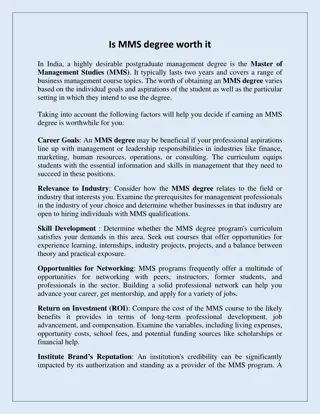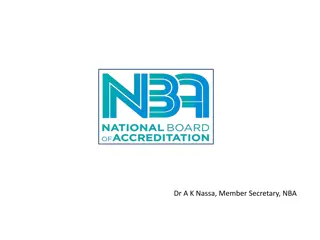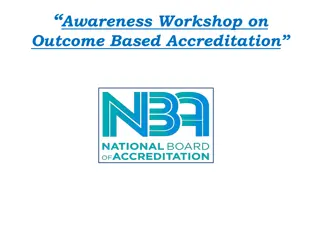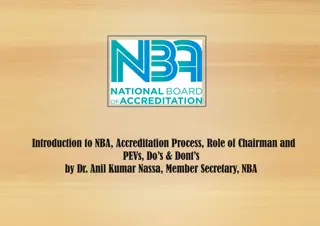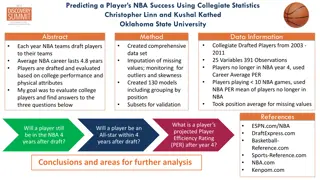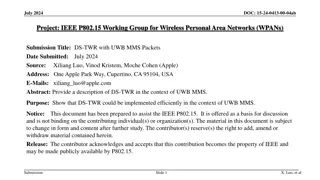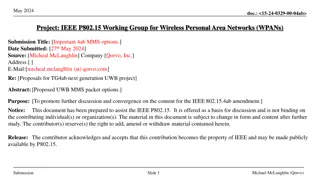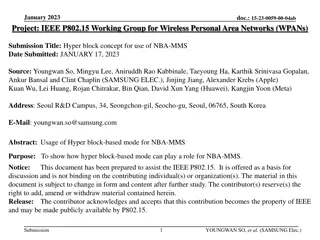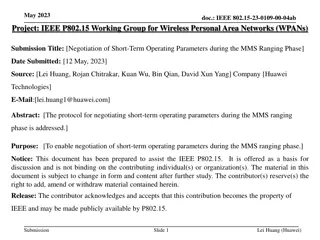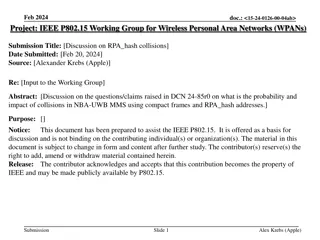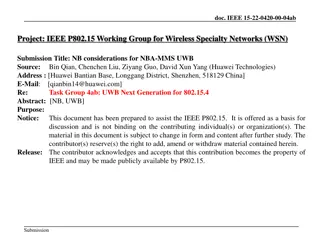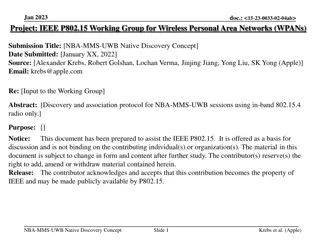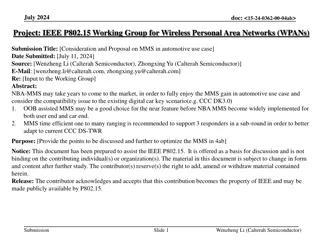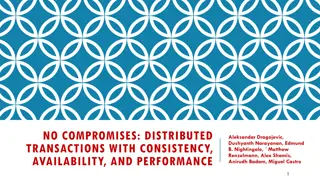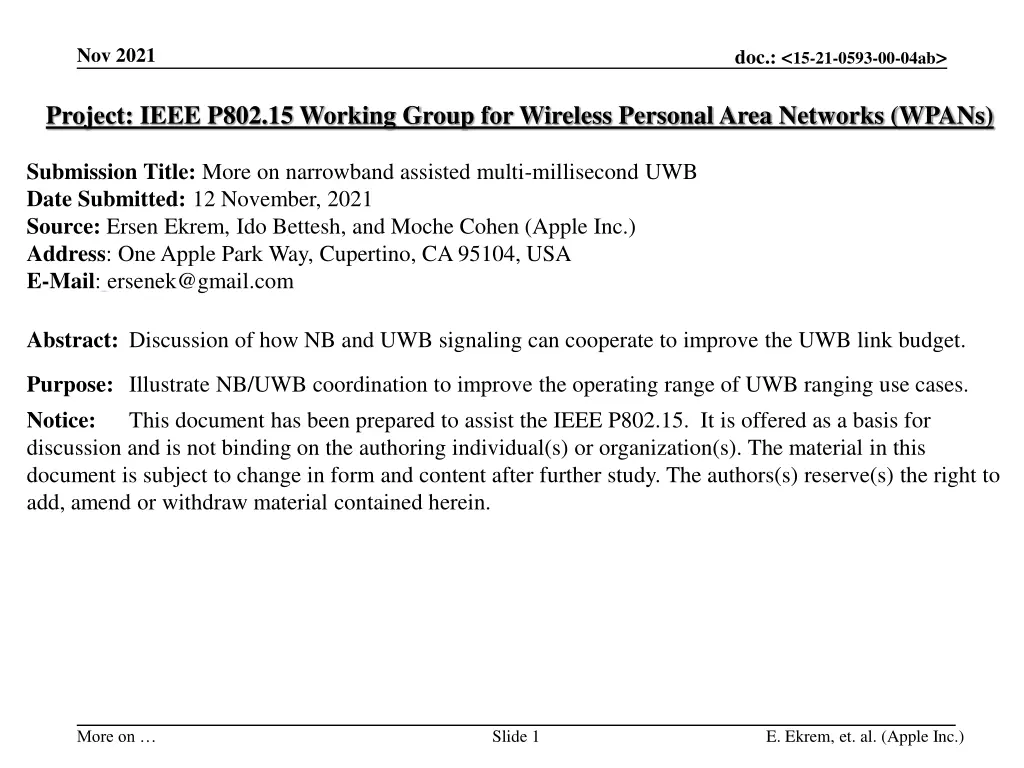
Enhancing UWB Performance Through NB/UWB Cooperation
Explore how narrowband (NB) and ultra-wideband (UWB) signaling can work together to improve UWB link budget and operating range for various use cases, such as ranging and high-throughput data applications. The document discusses techniques like coordinated PHY signaling, additional channels, and improved accuracy, among others, to enhance UWB functionality. This collaboration aims to reduce complexity, improve power consumption, and support diverse wireless protocols effectively.
Download Presentation

Please find below an Image/Link to download the presentation.
The content on the website is provided AS IS for your information and personal use only. It may not be sold, licensed, or shared on other websites without obtaining consent from the author. If you encounter any issues during the download, it is possible that the publisher has removed the file from their server.
You are allowed to download the files provided on this website for personal or commercial use, subject to the condition that they are used lawfully. All files are the property of their respective owners.
The content on the website is provided AS IS for your information and personal use only. It may not be sold, licensed, or shared on other websites without obtaining consent from the author.
E N D
Presentation Transcript
Nov 2021 doc.: <15-21-0593-00-04ab> Project: IEEE P802.15 Working Group for Wireless Personal Area Networks (WPANs) Submission Title: More on narrowband assisted multi-millisecond UWB Date Submitted: 12 November, 2021 Source: Ersen Ekrem, Ido Bettesh, and Moche Cohen (Apple Inc.) Address: One Apple Park Way, Cupertino, CA 95104, USA E-Mail: ersenek@gmail.com Abstract: Discussion of how NB and UWB signaling can cooperate to improve the UWB link budget. Purpose: Illustrate NB/UWB coordination to improve the operating range of UWB ranging use cases. Notice: This document has been prepared to assist the IEEE P802.15. It is offered as a basis for discussion and is not binding on the authoring individual(s) or organization(s). The material in this document is subject to change in form and content after further study. The authors(s) reserve(s) the right to add, amend or withdraw material contained herein. Slide 1 E. Ekrem, et. al. (Apple Inc.) More on
Nov 2021 doc.: <15-21-0593-00-04ab> PAR Objective Safeguards so that the high throughput data use cases will not cause significant disruption to low duty-cycle ranging use cases Interference mitigation techniques to support higher density and higher traffic use cases Other coexistence improvement Proposed Solution (how addressed) Backward compatibility with enhanced ranging capable devices (ERDEVs) Improved link budget and/or reduced air-time Use coordinated PHY signaling (NB and UWB) to improve link budget and/or to reduce air-time Additional channels and operating frequencies Improvements to accuracy / precision / reliability and interoperability for high-integrity ranging Reduced complexity and power consumption Off-loading of functionality to lower-complexity/power NB PHY helps reduce complexity of heavier UWB sub-system Exploit tightly coupled concurrent operation of NB to help UWB Hybrid operation with narrowband signaling to assist UWB Enhanced native discovery and connection setup mechanisms Sensing capabilities to support presence detection and environment mapping Low-power low-latency streaming Higher data-rate streaming allowing at least 50 Mbit/s of throughput Support for peer-to-peer, peer-to-multi-peer, and station-to- infrastructure protocols Infrastructure synchronization mechanisms Slide 2 E. Ekrem, et. al. (Apple Inc.) More on
Nov 2021 doc.: <15-21-0593-00-04ab> NBA-MMS UWB: A refresher from July 2021 A synergistic interplay between NB and UWB: Tight coupling between radios leading to link budget improvement Tight coupling between NB and UWB radios: NB will provide UWB precise timing and frequency offsets to assist in acquisition NB will own data exchange on behalf of UWB (status signaling, etc.) Link budget improvement: UWB will have preamble-only packets (no SFD, no data) There will be multiple fragments separated by 1 ms for further link budget boost Slide 3 E. Ekrem, et. al. (Apple Inc.) More on
Nov 2021 doc.: <15-21-0593-00-04ab> Narrowband Assisted Multi-Millisecond UWB Each UWB fragment is a preamble-only packet NB will take care of timing and frequency offset estimation & data exchange. Slide 4 E. Ekrem, et. al. (Apple Inc.) More on
Nov 2021 doc.: <15-21-0593-00-04ab> Possible UWB Fragment Structure Preamble structure: Repetition of the same symbol Symbol duration ~ 1-2 microseconds Ipatov, Golay sequences could be used PRF: Could be similar the current ones in HRP such as 64, 128 MHz. Fragment duration: Flexible enough to trade-off between co-existence and PA complexity Duration ~ 30 - 300 usec Number of fragments: Dynamic adjustment with options such as 1, 2, 4, 8 16, 32. Slide 5 E. Ekrem, et. al. (Apple Inc.) More on
Nov 2021 doc.: <15-21-0593-00-04ab> Potential Link Budget Improvement Almost 18 dB link budget improvement over ND packet! Slide 6 E. Ekrem, et. al. (Apple Inc.) More on
Nov 2021 doc.: <15-21-0593-00-04ab> NB Radio O-QPSK from 15.4 is very attractive: Widely adopted in CSA (formerly ZigBee)/Thread Efficient Tx implementation with good Rx sensitivity UNII-3 band (5725-5850 MHz) is favorable: 2.4 GHz is crowded and far from UWB bands. Among UNII bands, UNII-3 is the only one worldwide available. High regulatory Tx power limits. Sufficient channel spacing for ACI rejection such as 5 MHz BW. Channel hopping to avoid deep fades Other UNII bands could be optional to have a future looking standard. Slide 7 E. Ekrem, et. al. (Apple Inc.) More on
Nov 2021 doc.: <15-21-0593-00-04ab> Air-time optimization for O-QPSK It is highly desirable to optimize the airtime of O-QPSK 250 kbps mode might be long for certain use cases Keep backward-compatibility and co-existence in mind: Preamble and SFD changes should be minimal Keeping spreading rate identical would help for that matter. Auto-rate detect could help with co-existence, too: SFD can be leveraged to distinguish different packet formats. Also, more energy efficient approach compared to PHR changes! Slide 8 E. Ekrem, et. al. (Apple Inc.) More on
Nov 2021 doc.: <15-21-0593-00-04ab> Air-time optimization for O-QPSK Air-time can be optimized by: Preamble length reduction Using higher data rates Slide 9 E. Ekrem, et. al. (Apple Inc.) More on


